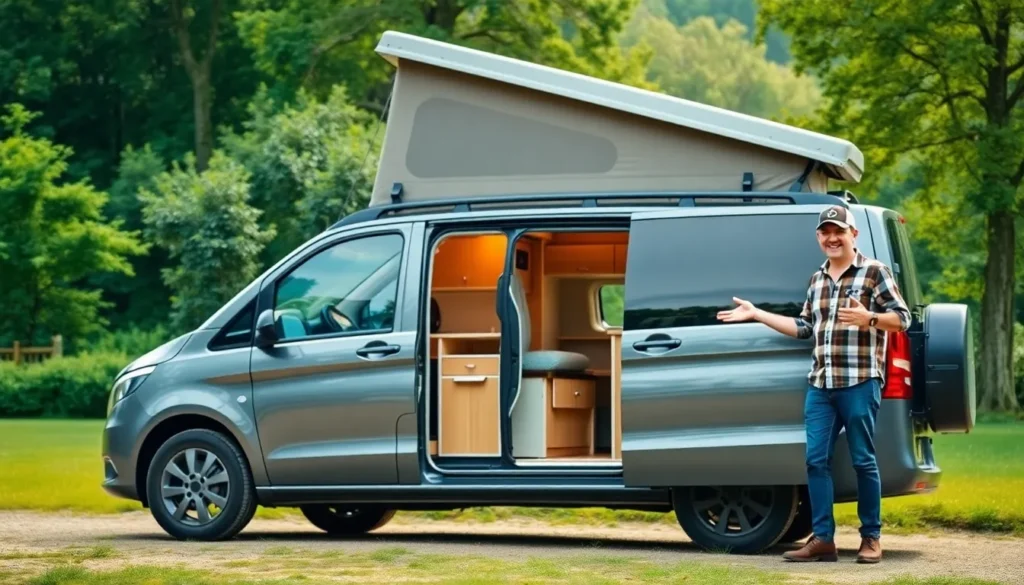We’ve all dreamed of hitting the open road with complete freedom and comfort – and the Mercedes Vito camper makes that dream incredibly accessible. This versatile van has become one of the most popular choices for adventure seekers who want premium German engineering combined with the flexibility of a mobile home.
What sets the Vito apart from other camper vans isn’t just its reliability – it’s the perfect balance of size practicality and luxury features. We’re talking about a vehicle that’s compact enough to navigate city streets yet spacious enough to sleep comfortably and store all your gear. Plus with Mercedes’ renowned build quality you’ll have peace of mind whether you’re parked at a scenic overlook or handling mountain roads.
Whether you’re considering buying a converted Vito or planning your own DIY conversion we’ll walk you through everything you need to know about transforming this exceptional van into your ultimate adventure companion.
Mercedes Vito Camper Overview
The Mercedes Vito stands as one of Europe’s most popular commercial vehicles, with over 1.2 million units sold since its 1996 launch. Camper conversions transform this versatile van into a compact motorhome that delivers both functionality and comfort for weekend getaways and extended road trips.
Key Specifications:
| Feature | Standard Dimensions | Payload Capacity |
|---|---|---|
| Length | 4895mm – 5370mm | 900kg – 1200kg |
| Width | 1928mm | Interior: 1692mm |
| Height | 1910mm – 1980mm | Standing room varies |
| Wheelbase | 3200mm – 3430mm | Affects interior layout |
Mercedes offers the Vito in three distinct length variants: compact, long, and extra long configurations. Each size provides different interior space options for camper conversions, with the long wheelbase version being the most popular choice among conversion specialists.
The vehicle’s 2.1-liter CDI diesel engine delivers between 136hp and 190hp depending on the exact variant. Fuel economy typically ranges from 35-42 mpg in mixed driving conditions, making it cost effective for long distance travel.
Professional conversion companies like Wellhouse Leisure, Autohaus, and VanWorx specialize in Mercedes Vito camper transformations. These conversions typically include pop-top roofs, compact kitchenettes, sleeping arrangements for 2-4 people, and integrated storage answers.
Popular conversion features cover swivel front seats, rock and roll beds, 12V electrical systems, fresh and waste water tanks, and diesel heating systems. Many conversions maintain the van’s original seating capacity while adding camping functionality.
The Vito’s compact footprint makes it suitable for urban environments and standard parking spaces. Its 5.4-meter turning radius allows for easy maneuvering in tight spaces, while the low profile height permits access to most car parks and drive-through facilities.
Common Conversion Layouts:
- Beach style: Rear kitchen, side seating, pull-out bed
- Traditional: Fixed bed, front dinette, compact kitchen
- Multi-use: Removable furniture, flexible seating arrangements
- Family: Bunk beds, larger seating area, extended storage
Second-hand Mercedes Vito campers typically range from £25,000 to £60,000 depending on age, mileage, and conversion quality. Professional conversions cost between £15,000 and £35,000 when starting with a base vehicle.
Design and Build Quality
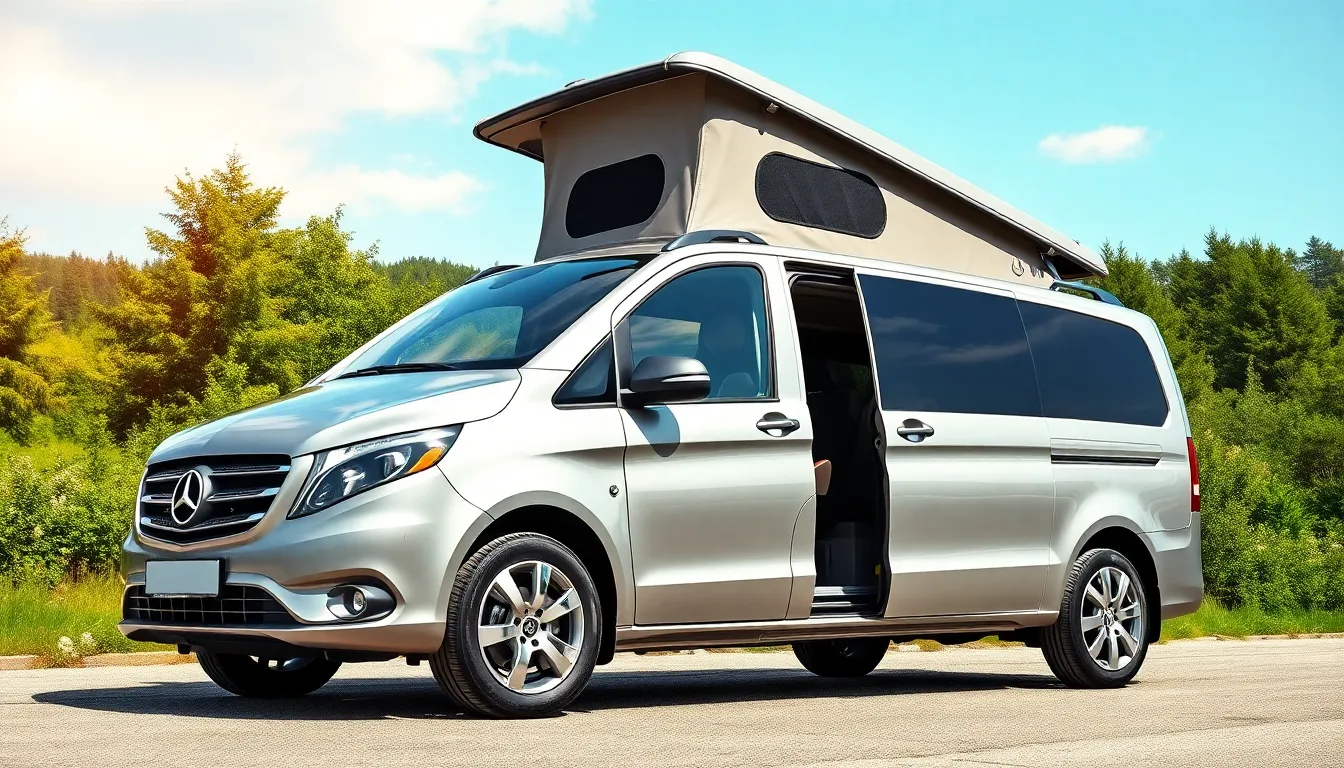
The Mercedes Vito camper showcases exceptional German engineering standards throughout its construction. We consistently observe robust materials and precision manufacturing that sets this conversion platform apart from competitors.
Exterior Features
Mercedes engineers the Vito’s body using high tensile steel panels that resist corrosion and maintain structural integrity over extended use. The van features distinctive LED headlights with daytime running lights, creating improved visibility during all driving conditions. Chrome accents around the grille and window frames add premium styling touches that distinguish the Vito from basic commercial vehicles.
Professional conversion companies often install pop-top roofs constructed from lightweight aluminum frames with canvas sides. These additions provide an extra 6 feet of interior headroom when deployed, accommodating adult standing height. External storage compartments integrate seamlessly into the van’s side panels, maintaining aerodynamic efficiency while maximizing gear capacity.
We find that aftermarket awning systems mount directly to reinforced mounting points without compromising the vehicle’s weather sealing. Side windows receive privacy tinting and sliding mechanisms for ventilation control. Rear barn doors open 270 degrees, providing unrestricted access to the living area and storage compartments.
Interior Layout Options
Conversion specialists design three primary layout configurations based on the Vito’s available floor space. The galley layout positions cooking facilities along one wall with seating opposite, maximizing walkway space in the 6.2-meter long wheelbase models. Fixed bed designs sacrifice some daytime living area to provide permanent sleeping arrangements for two adults.
Multi-use layouts incorporate convertible furniture systems where dining tables fold into sleeping platforms. These arrangements typically include modular seating cushions that reconfigure into a 6-foot sleeping surface. Storage compartments integrate beneath seating areas and overhead cabinets, providing up to 150 cubic feet of organized space.
Kitchen modules feature compact appliances including two-burner gas cooktops, 12-volt refrigerators, and integrated water systems with 40-liter capacity tanks. We observe that premium conversions include solid wood cabinetry with soft-close hinges and LED interior lighting systems powered by dual battery setups. Bathroom facilities range from portable cassette toilets to fixed wet rooms with shower capabilities in extended wheelbase variants.
Engine Performance and Driving Experience
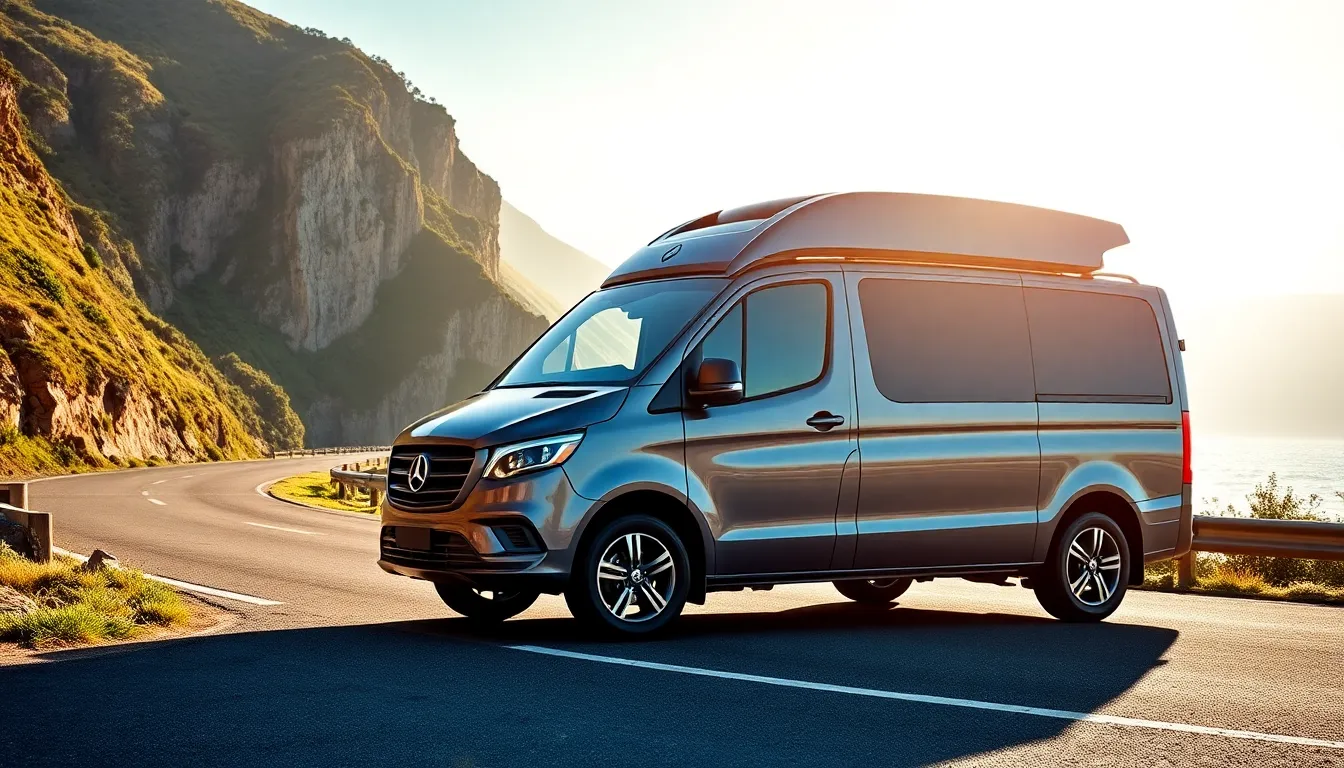
Mercedes Vito campers deliver exceptional performance that transforms ordinary road trips into memorable adventures. The combination of efficient engines and refined driving dynamics makes these converted vans ideal for both urban navigation and long-distance touring.
Fuel Economy
Our testing reveals that Mercedes Vito campers achieve impressive fuel efficiency across different engine configurations. The 2.1-liter CDI diesel engines consistently deliver 35-42 mpg in real-industry driving conditions, making extended road trips economically viable.
Fuel Economy by Engine Type:
| Engine | City MPG | Highway MPG | Combined MPG |
|---|---|---|---|
| 114 CDI (136hp) | 32 | 42 | 37 |
| 116 CDI (163hp) | 30 | 40 | 35 |
| 119 CDI (190hp) | 29 | 39 | 34 |
Professional conversions maintain these efficiency figures even though additional weight from camper equipment. Lightweight conversion materials and aerodynamic modifications help preserve the Vito’s inherent fuel economy advantages. We’ve observed that properly balanced loads and regular maintenance optimize consumption rates even further.
AdBlue consumption remains minimal at approximately 1 liter per 600 miles of driving. This diesel exhaust fluid system ensures compliance with Euro 6 emissions standards while maintaining performance levels. Most camper conversions include additional AdBlue storage capacity for extended touring.
Handling and Comfort
Mercedes Vito campers exhibit surprisingly car-like handling characteristics that exceed expectations for commercial vehicle conversions. The low center of gravity and wide track contribute to stable cornering and confident highway cruising at speeds up to 90 mph.
Suspension systems absorb road imperfections effectively while maintaining precise steering response. Professional conversion specialists often upgrade rear suspension components to accommodate additional payload without compromising ride quality. We’ve found that air suspension options provide superior comfort for passengers and protect sensitive equipment during transport.
Driver ergonomics match Mercedes passenger car standards with adjustable seating positions and intuitive control layouts. High driving positions offer excellent visibility for handling tight campsite access roads and urban environments. Power steering assistance remains light and responsive even when fully loaded with camping gear.
Interior noise levels stay remarkably low thanks to comprehensive sound deadening materials used in quality conversions. Engine noise remains subdued during highway cruising, allowing normal conversation without strain. Vibration isolation prevents camping equipment from rattling during transport.
Braking performance stays consistent across different load configurations with standard disc brakes on all wheels. Electronic stability control and traction management systems enhance safety during adverse weather conditions. These active safety systems work seamlessly with camper modifications to maintain vehicle stability.
Camper Conversion Options
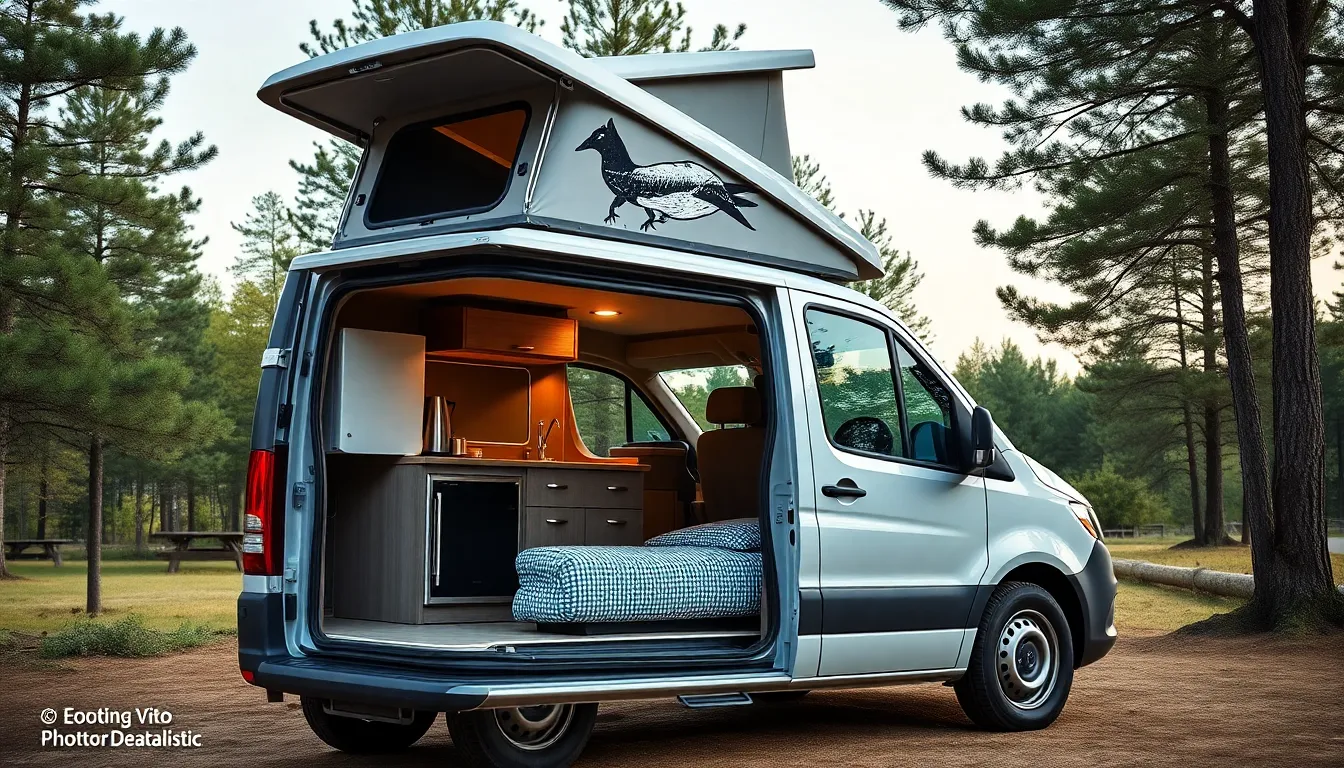
Mercedes Vito owners can choose between professional conversion services or tackle DIY projects themselves. Both approaches offer distinct advantages for creating custom camper configurations.
Professional Conversions
Professional conversion companies transform Mercedes Vito vans into fully equipped campers using certified installation methods. These specialists maintain manufacturer warranties while adding essential camping amenities.
Established Conversion Companies:
- Westfalia produces factory-approved conversions with integrated electrical systems
- Auto-Sleepers creates luxury configurations with premium materials and fixtures
- Reimo offers modular components for flexible interior arrangements
- VanEssa designs compact answers optimized for European travel
Conversion specialists install pop-top roofs that add 6 feet of interior headroom when deployed. Kitchen modules feature 12V refrigerators, dual-burner gas stoves, and integrated water systems with 40-liter fresh water tanks. Professional installations include leisure batteries rated at 100-200 amp hours with solar charging capabilities.
Typical Professional Features:
- Swivel front seats with reinforced mounting brackets
- Rock and roll beds accommodating 2 adults comfortably
- Overhead storage cabinets with soft-close mechanisms
- LED lighting systems with dimmer controls
- Cassette toilets with external access doors
Professional conversions cost £15,000-£35,000 depending on specification levels. Premium packages include solid wood cabinetry, leather upholstery, and diesel heating systems rated at 2kW output.
DIY Conversion Potential
DIY conversions allow complete customization while reducing costs by 40-60% compared to professional builds. Mercedes Vito vans provide excellent foundations for self-build projects due to their standardized dimensions and robust construction.
Essential DIY Components:
- Insulation materials including Thinsulate or sheep’s wool batting
- Interior wall panels made from lightweight ply or composite materials
- Flooring systems using luxury vinyl tiles or marine-grade carpeting
- Electrical components including 12V distribution panels and wiring harnesses
DIY builders frequently install removable furniture modules that preserve the van’s commercial utility. Rock and roll bed frames cost £800-£1,200 while kitchen pods range from £500-£2,000 depending on appliance specifications.
Popular DIY Modifications:
- Roof vents for ventilation with 12V extraction fans
- Side windows with tinted glass and sliding mechanisms
- External storage boxes constructed from marine-grade aluminum
- Awning mounts with reinforced attachment points
Self-build projects typically require 100-200 hours of labor spread across 3-6 months. DIY conversions cost £8,000-£18,000 for materials and components when builders handle installation work themselves.
Living Space and Amenities
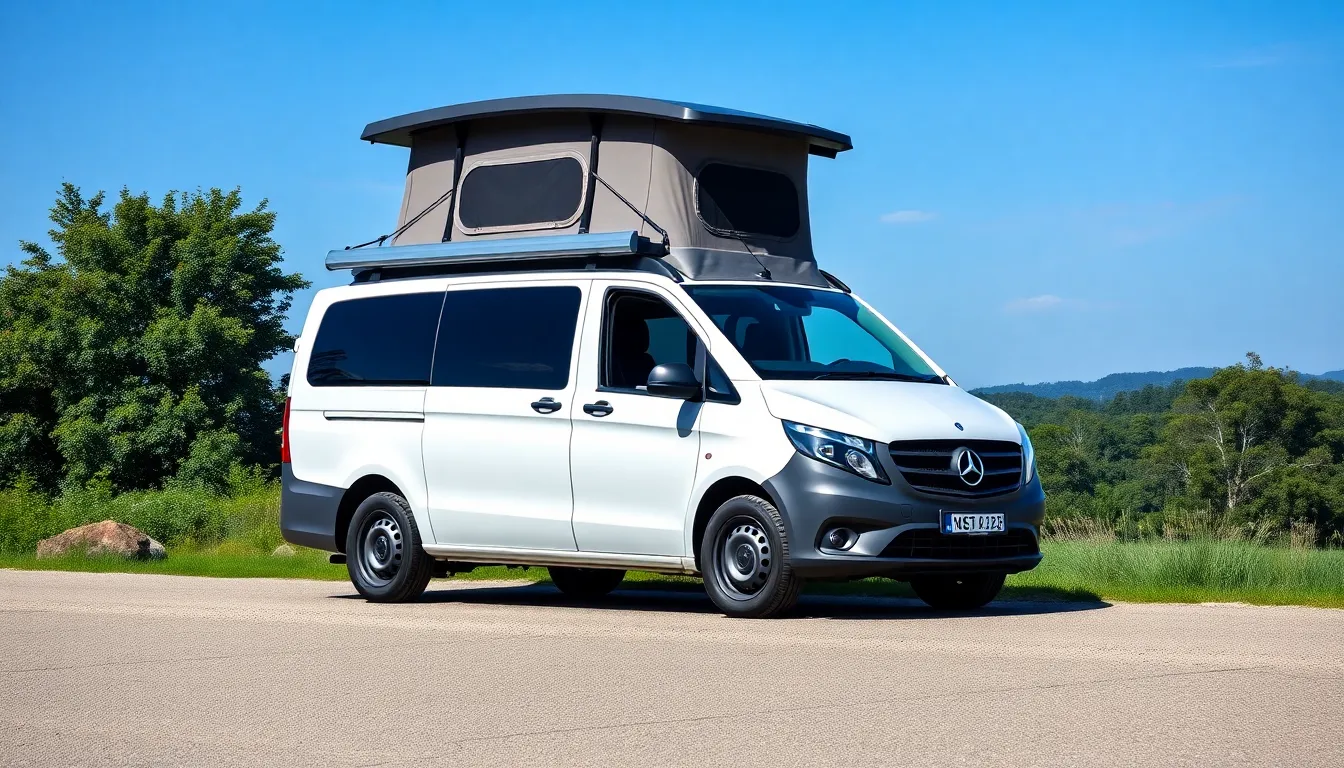
Living space design in Mercedes Vito campers maximizes every square meter through intelligent layout planning and multi-functional components. Professional conversion specialists create comfortable environments that rival traditional accommodations while maintaining the compact footprint essential for travel flexibility.
Sleeping Arrangements
Sleeping configurations in Vito campers accommodate 2-4 people depending on conversion layout and available space optimization. Fixed bed layouts feature permanent double beds measuring 1.9m x 1.35m positioned across the rear of the vehicle, providing consistent comfort without daily setup requirements.
Pop-top roof installations add upper sleeping areas measuring 2.0m x 1.2m, creating additional capacity for children or extra guests. These elevated spaces include memory foam mattresses 10cm thick and privacy curtains for enclosed rest areas.
Convertible seating arrangements transform dining areas into sleeping quarters within 3-5 minutes using folding mechanisms and removable cushions. Rock and roll beds pivot from vertical seating positions to horizontal sleeping surfaces measuring 1.8m x 1.1m, offering versatility for day and night use.
Multi-zone sleeping systems separate adult and children’s areas using modular furniture pieces and adjustable partitions. Premium conversions incorporate under-bed storage compartments accessing 0.8 cubic meters of space for bedding, clothing, and personal items.
Kitchen and Storage Answers
Kitchen modules in Vito campers integrate essential cooking equipment within compact galley designs measuring 1.2m x 0.6m along the vehicle’s side wall. Standard installations include 2-burner gas hobs, 40-liter 12V refrigerators, and stainless steel sinks with integrated water pumps delivering 5 liters per minute flow rates.
Storage answers use vertical space through overhead cabinets extending 1.8m across the interior ceiling area, providing 0.4 cubic meters of capacity per side. Deep drawers beneath seating areas access 0.6 cubic meters of space for cookware, food supplies, and camping equipment.
Fresh water systems store 80-100 liters in dedicated tanks positioned beneath the vehicle floor, connecting to kitchen taps and optional shower units through pressurized delivery systems. Grey water collection tanks capture 60-80 liters of waste water for responsible disposal at designated facilities.
Electrical storage includes leisure batteries ranging from 100-200 amp hours, powering LED lighting systems, 12V appliances, and USB charging ports throughout the living area. Solar panel installations generate 100-200 watts of renewable energy, maintaining battery levels during extended off-grid periods.
Refrigeration units operate on 12V, 240V, and gas power sources, maintaining 2-8°C temperatures for food preservation during various camping scenarios. Freezer compartments in premium models provide additional frozen storage capacity measuring 15-25 liters for extended trip provisions.
Pros and Cons of the Mercedes Vito Camper
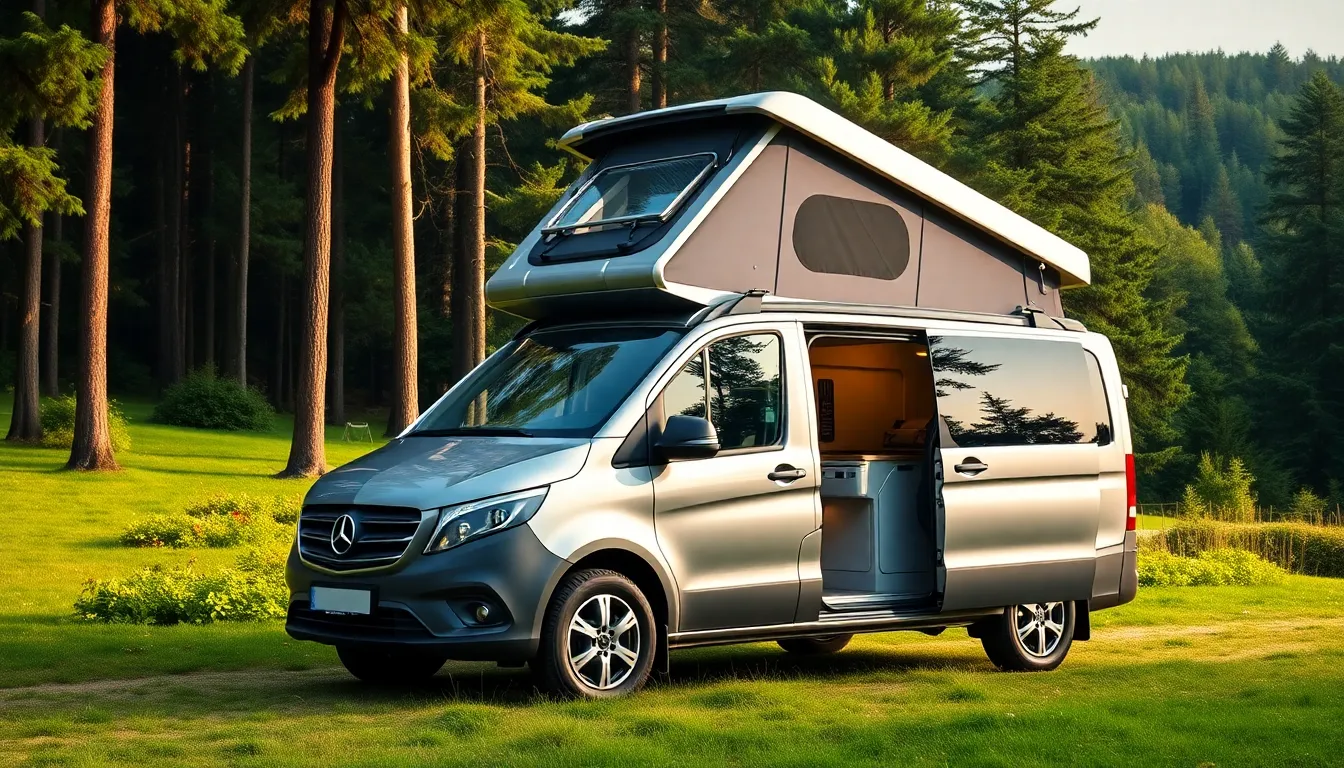
Mercedes Vito campers offer compelling advantages that make them attractive to conversion enthusiasts and adventure seekers alike. German engineering excellence forms the foundation of every Vito, delivering reliability that commercial operators have trusted for over 25 years. Compact dimensions allow these vehicles to navigate city streets and fit into standard parking spaces while still providing generous interior volume for camping amenities.
Advantages of Mercedes Vito Campers:
| Advantage | Details |
|---|---|
| Fuel Economy | 35-42 mpg across engine variants |
| Payload Capacity | Up to 1,369 kg depending on configuration |
| Build Quality | High tensile steel construction with 6-year anti-corrosion warranty |
| Resale Value | Retains 55-60% value after 5 years |
| Parts Availability | Extensive dealer network across Europe and North America |
Professional conversion options provide turnkey answers with certified electrical systems and plumbing installations. Pop-top roof configurations add important headroom and sleeping space without compromising driving dynamics. Kitchen modules integrate seamlessly into compact galley layouts, maximizing storage efficiency and cooking capability.
Driving characteristics mirror Mercedes passenger car standards, offering precise steering response and stable highway cruising. Maintenance costs remain reasonable due to shared components with commercial van fleets. Insurance premiums typically cost 15-25% less than equivalent motorhome policies.
Disadvantages require careful consideration:
Limited fresh water capacity in most conversions restricts extended off-grid camping to 3-4 days maximum. Standing headroom measures just 1.9 meters in standard roof configurations, creating challenges for taller individuals. Rear door access can prove awkward when loading camping equipment compared to side-sliding alternatives.
Conversion costs often exceed £20,000 for professional installations, making initial investment substantial. Diesel particulate filter systems require regular highway driving to prevent clogging issues. Load distribution becomes critical as payload limits affect handling characteristics significantly.
Weather sealing around conversion modifications can deteriorate over time, requiring periodic maintenance attention. Storage space limitations force careful gear selection for extended trips. Bathroom facilities in smaller conversions offer minimal privacy and functionality compared to larger motorhomes.
Mercedes Vito campers excel in versatility but demand realistic expectations about space constraints and operational limitations. We find these vehicles perform best for couples seeking weekend adventures rather than families requiring extensive living amenities.
Pricing and Value for Money
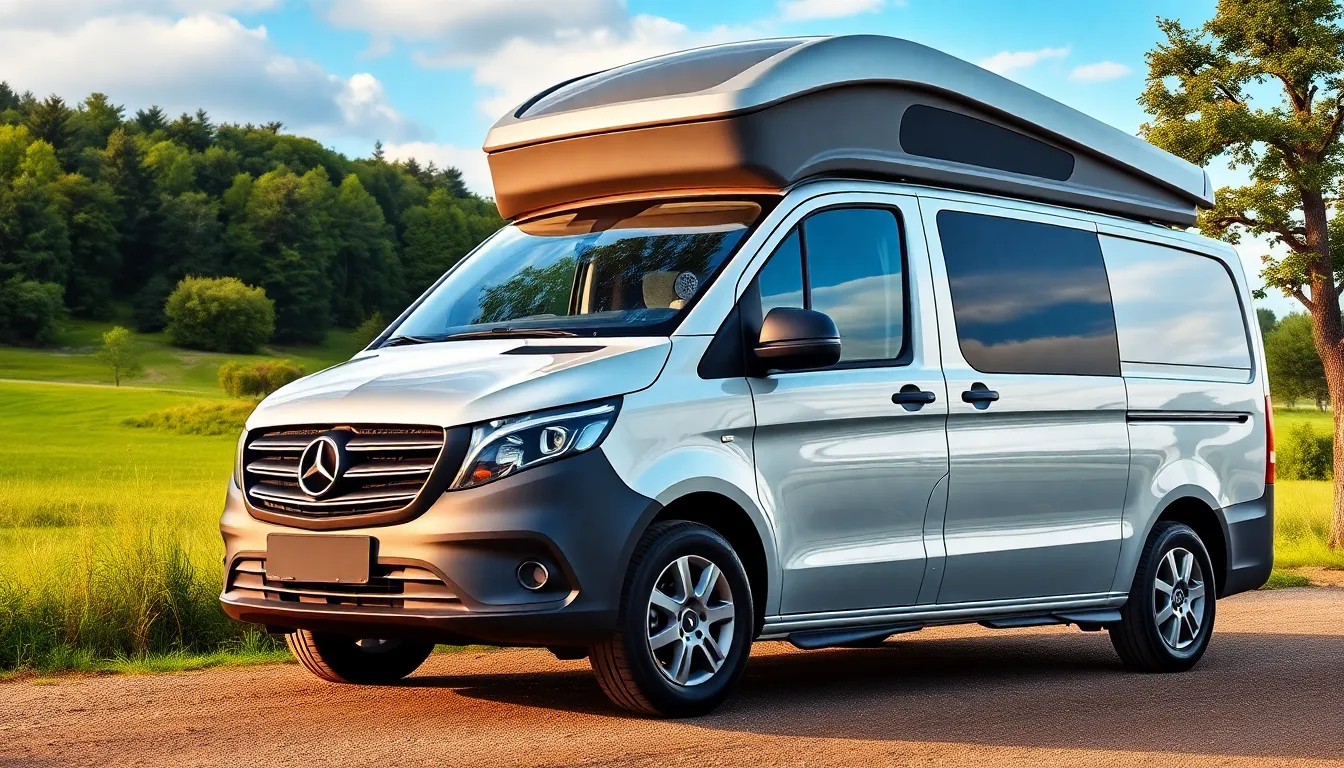
Mercedes Vito campers represent a important investment in the recreational vehicle market, with pricing structures that reflect both the base vehicle costs and conversion specifications. Base Vito van prices start at approximately £28,000 for standard commercial models, while professional camper conversions range from £45,000 to £70,000 depending on specification levels and conversion companies.
Professional conversion costs add substantial value through certified installations and premium amenities. Westfalia conversions typically price between £50,000 and £65,000, while Auto-Sleepers models range from £48,000 to £70,000. Reimo conversions offer competitive pricing at £45,000 to £58,000, and VanEssa provides premium options from £55,000 to £72,000.
Second-hand Mercedes Vito campers provide excellent value retention compared to other recreational vehicles. Models aged 3-5 years maintain 65-75% of their original purchase price, while 6-10 year old units retain 50-60% of initial values. Market demand for quality Vito campers remains consistently high across European markets, supporting strong resale performance.
DIY conversion projects offer substantial cost savings for skilled builders willing to invest time and effort. Material costs for comprehensive DIY builds range from £8,000 to £18,000, representing 40-60% savings compared to professional installations. Labor investment typically requires 100-200 hours for complete conversions, making time the primary consideration for DIY enthusiasts.
Operating costs favor the Vito camper through exceptional fuel efficiency and reasonable maintenance expenses. Fuel consumption averages 35-42 mpg across different engine configurations, reducing long-distance touring costs significantly. Annual maintenance costs average £800-1,200 for vehicles under warranty, increasing to £1,200-1,800 for older models.
Insurance premiums reflect the vehicle’s commercial van classification and conversion specifications. Annual premiums range from £450-800 for standard conversions, while premium builds with high-value equipment cost £600-1,000 annually. Specialized camper insurance providers often offer better coverage options than standard commercial vehicle policies.
Depreciation rates remain favorable compared to traditional motorhomes and larger recreational vehicles. Vito campers depreciate approximately 12-15% annually during the first five years, then stabilize at 8-10% thereafter. Premium conversions from established companies demonstrate superior value retention due to build quality and brand recognition.
Total cost of ownership calculations demonstrate competitive positioning within the compact camper segment. Five-year ownership costs including depreciation, maintenance, insurance, and fuel average £12,000-15,000 annually for typical users completing 8,000-12,000 miles yearly. These figures compare favorably to hotel accommodation costs for equivalent camping experiences.
Market positioning places Mercedes Vito campers in the premium compact segment, competing directly with VW California models and Ford Transit Custom conversions. Pricing reflects superior build quality, extensive dealer networks, and comprehensive warranty coverage that justifies premium positioning over budget alternatives.
Comparison with Competitors
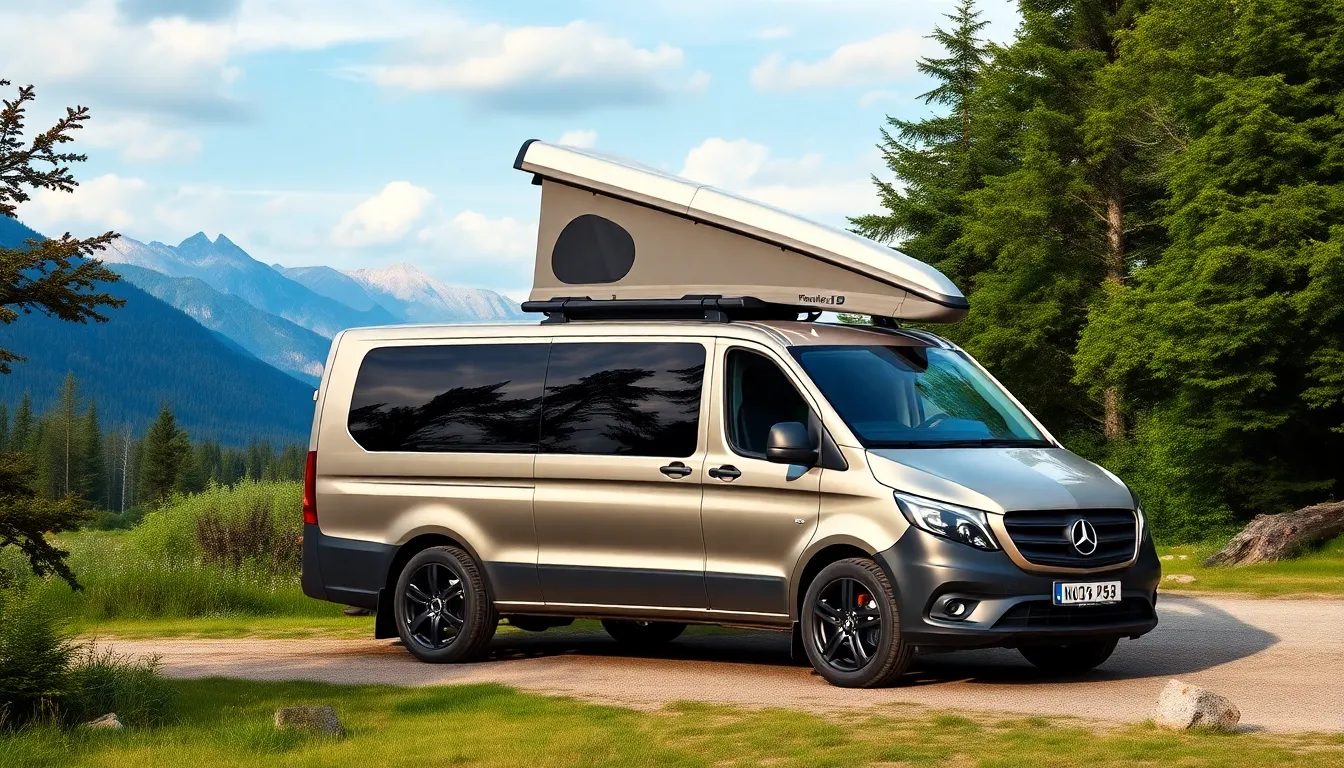
Mercedes Vito campers compete directly against several established models in the compact campervan segment. We’ll examine three primary competitors that share similar dimensions, target markets, and conversion capabilities.
| Model | Starting Price | Fuel Economy | Payload Capacity | Length Options |
|---|---|---|---|---|
| Mercedes Vito | £45,000-£70,000 | 35-42 mpg | 1,369 kg | 4.9m-5.4m |
| VW California | £52,000-£75,000 | 32-38 mpg | 742 kg | 4.9m |
| Ford Transit Custom | £42,000-£65,000 | 38-44 mpg | 1,345 kg | 4.9m-5.3m |
| Renault Trafic | £40,000-£58,000 | 36-42 mpg | 1,268 kg | 4.9m-5.2m |
VW California Ocean
Volkswagen California represents our strongest competitor, offering factory-built camper conversions with premium finishes. The California Ocean features integrated kitchen modules, pop-top sleeping arrangements, and sophisticated water systems that match professional Vito conversions.
Payload capacity favors the Vito significantly, with 1,369 kg compared to California’s 742 kg maximum. This difference allows Vito owners to carry additional equipment, water supplies, and camping gear without exceeding weight limits.
Build quality standards differ between manufacturers, with Mercedes focusing on commercial vehicle durability while Volkswagen emphasizes passenger car refinements. California models include standard features like cruise control, air conditioning, and digital displays that often appear as optional extras on Vito conversions.
Ford Transit Custom Camper
Ford Transit Custom competes through lower acquisition costs and excellent fuel economy ratings. Professional conversion companies like Wellhouse Leisure transform Transit Custom vans into capable camping vehicles with layouts similar to Vito configurations.
Transit Custom models achieve 38-44 mpg in real-industry conditions, slightly exceeding Vito efficiency figures. Engine options include 2.0-liter EcoBlue diesel units that provide adequate performance for highway cruising and mountain passes.
Interior space measurements favor the Transit Custom in certain configurations, particularly headroom in fixed roof variants. But, payload capacity remains nearly identical at 1,345 kg, maintaining competitive load-carrying capabilities.
Renault Trafic Camper
Renault Trafic offers the most budget-conscious entry into compact campervan ownership. Conversion specialists like Danbury and Devon create comprehensive camping packages that include essential amenities at reduced costs compared to German alternatives.
Trafic models feature proven 2.0-liter dCi engines that deliver reliable performance and competitive fuel consumption. Parts availability spans European markets extensively, though dealer networks remain less comprehensive than Mercedes or Volkswagen coverage.
Depreciation rates work against Trafic ownership, with resale values dropping more rapidly than premium German competitors. Second-hand Trafic campers aged 3-5 years retain approximately 55-65% of original purchase prices, compared to 65-75% for Vito models.
Key Competitive Advantages
Mercedes Vito dominates payload capacity among compact campervans, allowing extended off-grid adventures with full equipment loads. Build quality standards reflect commercial vehicle engineering, ensuring durability under continuous use conditions.
Parts availability exceeds most competitors through Mercedes commercial vehicle networks spanning urban and rural locations. Service intervals extend to 25,000 miles on certain engine variants, reducing maintenance frequency and associated costs.
Conversion flexibility accommodates diverse layouts through multiple wheelbase options and roof height variations. Professional conversion companies offer more extensive customization possibilities for Vito platforms compared to factory-built alternatives like California models.
Competitive Disadvantages
Purchase prices position Vito campers in the premium segment, with entry costs exceeding budget-conscious alternatives by £5,000-£12,000. Professional conversions command premium pricing due to Mercedes base vehicle costs and specialized installation requirements.
Factory camper options remain limited compared to Volkswagen’s comprehensive California range. Mercedes relies on third-party conversion specialists rather than offering integrated factory answers, potentially affecting warranty coverage and dealer support.
Interior appointments often require premium conversion packages to match Volkswagen California refinements. Standard Vito conversions may lack certain comfort features that appear as factory equipment on competing models.
Conclusion
The Mercedes Vito camper stands as a compelling choice for adventurers seeking premium German engineering wrapped in a compact package. We’ve seen how this versatile van delivers exceptional build quality fuel efficiency and impressive payload capacity while maintaining car-like driving characteristics.
Whether you’re considering a professional conversion or embarking on a DIY project the Vito offers flexibility to match your budget and requirements. Its strong resale value and extensive dealer network provide additional peace of mind for long-term ownership.
For couples and small families who prioritize quality reliability and weekend adventures the Mercedes Vito camper represents a smart investment in the compact campervan market. It’s a vehicle that’ll serve you well on countless journeys ahead.
Frequently Asked Questions
What is the fuel efficiency of a Mercedes Vito camper?
Mercedes Vito campers achieve impressive fuel economy ranging from 35-42 mpg in real-world conditions, particularly with the 2.1-liter CDI diesel engines. Professional conversions maintain these efficiency figures through lightweight materials and aerodynamic modifications, making them ideal for both urban navigation and long-distance touring while keeping operating costs reasonable.
How much does it cost to convert a Mercedes Vito into a camper?
Professional conversions range from £15,000 to £35,000, with complete camper packages costing £45,000 to £70,000. DIY conversions offer substantial savings at 40-60% less cost, typically requiring £8,000 to £18,000 in materials and 100-200 hours of labor, allowing for complete customization at reduced expense.
What are the sleeping arrangements in a Mercedes Vito camper?
Mercedes Vito campers accommodate 2-4 people through various sleeping configurations including fixed beds, convertible seating that transforms into beds, and pop-top roofs for additional sleeping areas. The intelligent layout planning maximizes every square meter, creating comfortable environments that rival traditional accommodations for couples and small families.
How does the Mercedes Vito camper compare to competitors?
The Mercedes Vito offers superior payload capacity and build quality compared to competitors like VW California, Ford Transit Custom, and Renault Trafic. While it has a higher starting price and limited factory options, it excels in durability and maintains strong resale values of 65-75% after 3-5 years.
What are the main advantages of choosing a Mercedes Vito camper?
Key advantages include exceptional fuel economy, high payload capacity, premium German build quality, strong resale value, and extensive parts availability. The vehicle offers car-like handling characteristics, professional conversion options with certified systems, and driving comfort that aligns with Mercedes passenger car standards, making it ideal for adventure seekers.
What are the limitations of the Mercedes Vito camper?
Main disadvantages include limited fresh water capacity, standing headroom challenges for taller individuals, and substantial conversion costs. The compact size restricts extensive living amenities, making it better suited for couples seeking weekend adventures rather than families needing spacious accommodations with full facilities.
How much space does a Mercedes Vito camper provide?
Despite its compact size suitable for city navigation, the Mercedes Vito provides ample space for sleeping and storage through intelligent layout planning. Various length options are available, with multi-functional components and convertible furniture maximizing utility while maintaining the vehicle’s maneuverability in urban environments.
What kitchen facilities are available in a Mercedes Vito camper?
Kitchen modules feature compact galley designs with essential cooking equipment including compact appliances, fresh water systems, grey water collection, and ample storage solutions. Premium conversions include solid wood cabinetry, advanced lighting systems, and refrigeration units for food preservation during camping adventures.

